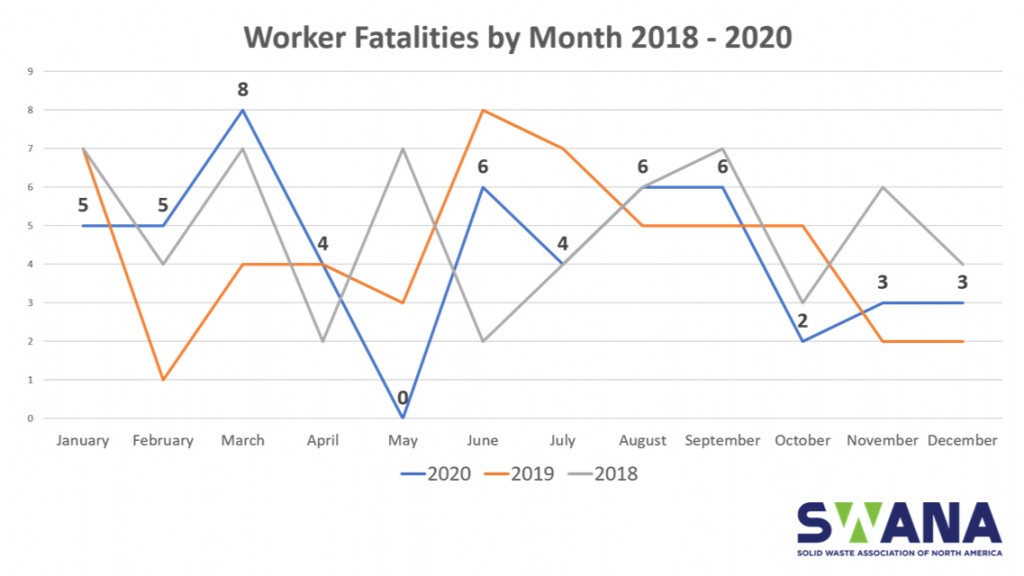52 avoidable fatalities in 2020 reflects little improvement for solid waste industry safety
Collection vehicle accidents remain main cause, pedestrian fatalities on the rise, according to SWANA Safety Summit

The Solid Waste Association of North America (SWANA) reported 52 municipal solid waste industry workers killed in 2020 in the United States and Canada, with nearly 70 percent occurring during collection. This data was shared at SWANA's virtual Safety Summit on February 25.
"There continues to be too many avoidable fatal incidents in and involving the solid waste industry," stated David Biderman, SWANA Executive Director & CEO. "This trend has continued into 2021, with 17 fatal incidents recorded in the first two months of the year. We can and must do better."
According to Jesse Maxwell, SWANA's Advocacy & Safety Senior Manager, who led the review of the 2020 Safety Statistics Report, "The 2020 data tells us that while the past year was certainly unusual for everyone, due to the pandemic, from the perspective of worker fatalities, we ended up looking fairly similar to 2019." He also noted that fatality numbers for 2020 don't include any recordable COVID-19 deaths, and that the total number of 52 solid waste industry fatalities for 2020 may change, if those become added later.
"Overall, we can see a pattern emerging over the years where we normally start off the year with a higher number of worker fatalities," said Maxwell. "There's a drop sometime in the spring, the numbers start to increase in early summer, and then again in early fall, with a dip into late fall and into winter. Then at the beginning of the next year, this pattern starts all over again."
According to SWANA data, the most common type of fatal event recorded in 2020 was a single vehicle accident in which only a waste collection vehicle was involved. The second most common fatality was being struck by a waste collection vehicle, either as a "helper" (a solid waste worker who rides on the outside back of collection vehicles) or when a driver was out of the cab. The data suggests that rushing through the job may be contributing to these tragic incidents, and that reminding collection crews of best practices for safety is in dire need.
Main causes of solid waste fatalities
Collection fatalities remained steady in 2020 compared to 2019, and were down from 2018 when 42 occurred. Fatal incidents at landfills fell from 11 in 2019 to 4 in 2020, and material recovery facilities (MRFs) similarly saw a drop in worker deaths from 4 in 2019 to 1 last year. Fatalities at transfer stations increased from 1 in 2019 to 3 in 2020.
"If a collection worker is killed while dumping a load at a landfill, then that fatality would be counted within the landfill category," noted Maxwell.
"As is the norm, the majority of fatalities in 2020 occurred when a worker is out on collection vehicle. This is the same trend that we see year after year."
Also notable in 2020, Maxwell pointed out, were the number of workers who were killed while doing mechanical work on a truck or a piece of equipment.
"This is not an area we talk much about normally, but there's obviously a need for us to focus on this as an area of concern, and to discuss ways of making work safer at the garage."
Maxwell continued by saying that one of the most important takeaways from the Safety Summit presentation on February 25th, is data showing the causes of worker fatalities in 2020.
"The number one cause of worker death this past year was a vehicle accident in which the worker was the only one involved. This is not being struck by another car or truck, but losing control and going off the road, often striking a tree or a pole. Though the underlying causes vary, and it isn't always clear in these cases, it seems reasonable to assume that speeding and distraction are likely feature factors."
"The second most common cause of death on the job was being struck by one's own waste truck, or by a co-worker. This represents a combination of helpers being out doing collection and being struck by their truck, or another driver on the worksite. This usually involved getting out of the cab for some reason, and then being struck by a truck when it rolls."
Pedestrian fatalities are up in solid waste
In addition to worker fatalities, SWANA also tracks events in which a member of the public is killed in a solid waste related incident. In 2020, 76 members of the public in the United States and Canada were killed in collisions with a solid waste collection vehicle, with about 62 percent being vehicle collisions. The past year saw slightly fewer fatalities than 2019 when there were 80, and continues the decline from 2018 when 101 members of the public died.
"Most of the deaths we see represent a collision with a solid waste industry vehicle, generally the most common cause by far," said Maxwell. "2020 saw slightly fewer fatalities than the previous year, 2019, which was a huge drop from 2018. And hopefully we'll continue to see this as a trend that continues to go down.
"I do want to point out that in 2020 about 17 percent of public deaths were the result of pedestrians being struck by a waste vehicle. In 2019 that was 16 percent and in 2018 it was about 11 percent.
"We are seeing an increase in pedestrian fatalities."
New Google Map digs deeper into solid waste industry fatalities
Near the end of the presentation Maxwell shared a screen capture of a new, interactive Google Map (shown above). Through the new Google Map, SWANA members can look closer at each fatality, find out basic information including whether it's a public or private incident, age of the victim, location of the incident, and other information.
According to SWANA's data, at the state level, New York had the most fatal incidents with 15, followed by California with 12, Texas with 11, Pennsylvania with 9, and Florida with 8. New York and California have both been in the top five states in number of fatalities for the past three years.
View interactive Google Map here.
On the new map, Maxwell concluded, "You can see the locations for all 2020 fatalities. You can also see a list of the top eight states and provinces with the most incidents in 2020.
"Population plays a major role on fatality numbers. A city's size is a pretty good indication of the number of incidents you are likely to have."
In addition to presenting the 2020 fatality data, SWANA's virtual Safety Summit brought together safety leaders from Waste Management, Republic, Waste Connections, Rumpke, Caterpillar, and other employers who provided attendees with useful information on how to reduce collisions, injuries, and accidents.
Recordings of the Safety Summit are available for sale at https://swana.org/safety-summit/.
To reduce fatal and non-fatal incidents across the solid waste industry, SWANA has developed a growing variety of safety resources.
SWANA's latest addition is a new, weekly newsletter, Safety Matters, which makes relevant safety guidance easily accessible to front-line employees and workers at all levels. SWANA encourages members to use it at safety meetings and toolbox talks to remind workers of safety hazards associated with solid waste management and how to avoid them.
To learn more about SWANA's Safety Initiatives, visit https://swana.org/initiatives/safety.



